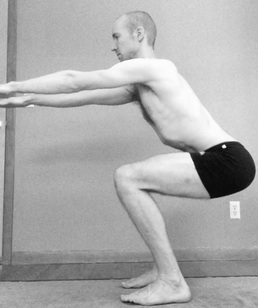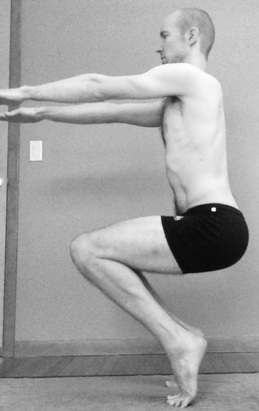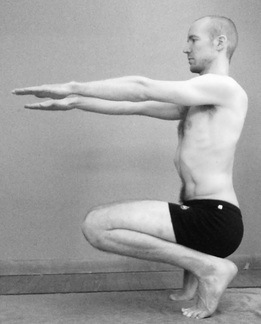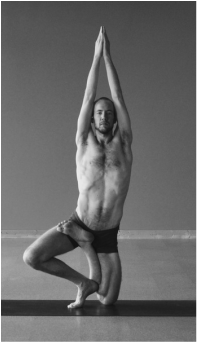|
The "Practice" posts are about progress and learning. The pictures and analysis of my own practice help me find areas that need improvement. This morning I took some time and tried to improve the engagement and alignment of my Chair Poses. There are 3 main variations of Chair in the Ghosh Lineage, and even though they look similar, the engagement of the back and legs is actually very different between the postures. The first part is simple enough. Feet flat on the floor and sit down halfway. The tricky part is in the back. Some teachers encourage an arched back where you pull your chest up and curve your lower back so your upper body is upright and looks like a ski slope. When we discussed this posture with Tony and he demonstrated, his back was almost completely straight. I have looked at some pictures of Chair Poses from other traditions and read some anatomy books, trying to figure out if there is a good reason to either arch the back or keep it straight. I have found evidence of straight backed and arched back Chair Poses. But I can't find any good anatomical evidence to arch the back in this pose, so I am going to practice keeping it straight for awhile. Keeping the back straight is complicated in this position because the quads are so engaged. It is easy to just let them pull the top of the pelvis forward which would then arch the back. Straightening the lower back requires some relaxation of the quads and some engagement of the hamstrings to tilt the pelvis back a little and flatten the low spine. The second part, Chair On Toes, is the power posture of this little sequence. Being up on the toes really changes the alignment of the legs, so the calves, quads, hamstrings, abs and back all engage differently. The flat back is easier to achieve in this position because the center of gravity is further forward. I was surprised to find that my hip and back engagement was easier and stronger from practicing the first part with a flat back. (This reminds me of the pelvic tilt in Eagle Pose, where I have been finding more stability and power by tilting the pelvis back. But that is for another time.) The third part, Chair On Heels, is challenging in its simplicity. This is a posture that requires very little muscular effort compared to the first two parts, and yogis have been trying to make it harder and harder. This is actually a pretty gentle posture, a safe and engaged way to bend deeply into the knees, warming them up. Some yogis like to hold their hips up an inch off of their heels for the power in the quadriceps. What this is more likely to do, especially over time, is to strain the tendons in the front of the knees. The same goes for the 'bouncing,' another great way to strain the knees. We are still warming the body at this point in the series, and we need to open it gradually.
Standing up out of Chair On Heels is another great place to strain the knees. A gentler way to come up is to bring the upper body forward, letting the hips go back and the feet come flat on the floor. It doesn't look nearly as bad-ass as powering straight back up out of this position, but it takes the pressure off of the knees.
1 Comment
Jaspal
1/17/2014 07:19:57 am
nice website, been following your blog after stumbling across it from Tonys FB page, i am going for his upcoming core 26 and tt in a few weeks. yeah regarding chair pose, my patella hurt for 2 years while doing the bikram series, i stopped doing bikram series about 7 months back and only practise tonys sequence, my patella pain has gone. Your definitely right about straining the tendons at the front of the knee. Thanks for the tip on getting out of the third part of chair, i have been getting a pain on the top of the knee recently, I have a feeling it could be from this, will try your method. thanks buddy!!!
Reply
Leave a Reply. |
This journal honors my ongoing experience with the practice, study and teaching of yoga.
My FavoritesPopular Posts1) Sridaiva Yoga: Good Intention But Imbalanced
2) Understanding Chair Posture 2) Why I Don't Use Sanskrit or Say Namaste 3) The Meaningless Drudgery of Physical Yoga 5) Beyond Bikram: Why This Is a Great Time For Ghosh Yoga Categories
All
Archives
November 2017
|





 RSS Feed
RSS Feed